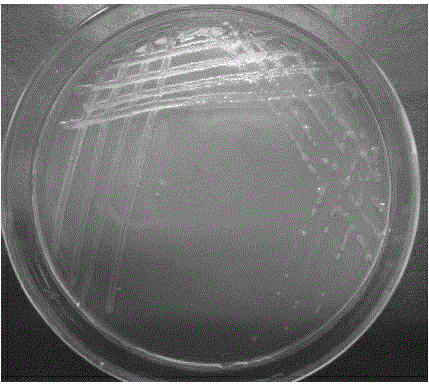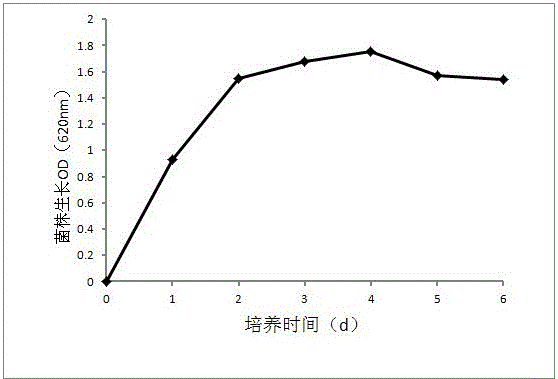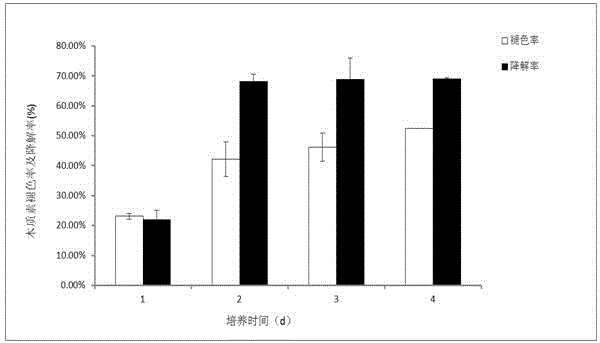Rice endophyte (Pantoea sp. Sd-1) for efficiently degrading lignin
A technology of endophytic bacteria and alkali lignin, which can be applied in the fields of bacteria, microorganisms, biological water/sewage treatment, etc., and can solve problems such as basic research gaps.
- Summary
- Abstract
- Description
- Claims
- Application Information
AI Technical Summary
Problems solved by technology
Method used
Image
Examples
Embodiment 1
[0015] Embodiment 1: the biological identification of bacterial strain
[0016] 1. Strain Morphological Characteristics
[0017] (1) Colony morphology characteristics: Streak inoculation of monoclonal colonies into PDA solid medium, place the plate upside down in a constant temperature incubator, incubate at 30°C for 1 to 3 days, observe the colony morphology, the colonies are light yellow, smooth, rounded edges, see attached figure 1 .
[0018] (2) Morphological characteristics of the bacteria: Gram-staining the strain and observing it with an optical microscope showed that the strain was a short rod-shaped, Gram-negative bacterium;
[0019] 2. Strain 16S rDNA Analysis
[0020] Bacterial Genomic DNA Extraction Kit was used to extract the genomic DNA of the bacterial strain, and the bacterial 16S rDNA general primer (27F, 1492R) was used to amplify the 16S rDNA fragment of the bacterial strain using the bacterial strain genomic DNA as a template, and the obtained ba...
Embodiment 2
[0025] Embodiment 2: the growth characteristic of bacterial strain in lignin liquid medium
[0026] The strains grown to the logarithmic phase were divided into 1.4 × 10 9 The inoculum amount of CFU was inoculated into liquid medium containing 3g / L alkali lignin, supplemented with 1% glucose and 0.5% peptone as the exogenous initial carbon source and nitrogen source, and cultured with shaking at 30°C and 170r / min , take a sample once a day and measure the growth OD value of the bacterial strain with a UV spectrometer, the results are shown in the attached figure 2 .
Embodiment 3
[0027] Embodiment 3: Bacterial strain is to lignin fading and degradation characteristics
[0028] The strains grown to the logarithmic phase were divided into 1.4 × 10 9 The inoculum amount of CFU was inoculated into the liquid medium containing 3g / L alkali lignin, supplemented with 1% glucose and 0.5% peptone as the exogenous initial carbon source and nitrogen source, and shaken at 30°C and 170r / min Cultured for 4 days, sampled once a day, the culture solution was centrifuged at 8000r / min for 15min, and the precipitate was discarded.
[0029]Adjust the pH of the supernatant to 7.6 with 1M NaOH, and measure the absorbance at 465nm with a UV spectrophotometer to calculate the fading rate. For the results, see image 3 .
[0030] Adjust the pH of the supernatant to 1-2 with 12M HCl, centrifuge at 12000r / min for 15min, take the precipitate, dry it at 50-60°C for 48h, weigh it to a constant weight, and calculate its degradation rate. For the results, see image 3 .
PUM
 Login to View More
Login to View More Abstract
Description
Claims
Application Information
 Login to View More
Login to View More - R&D
- Intellectual Property
- Life Sciences
- Materials
- Tech Scout
- Unparalleled Data Quality
- Higher Quality Content
- 60% Fewer Hallucinations
Browse by: Latest US Patents, China's latest patents, Technical Efficacy Thesaurus, Application Domain, Technology Topic, Popular Technical Reports.
© 2025 PatSnap. All rights reserved.Legal|Privacy policy|Modern Slavery Act Transparency Statement|Sitemap|About US| Contact US: help@patsnap.com



